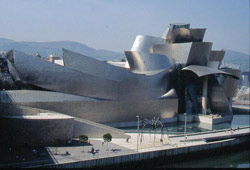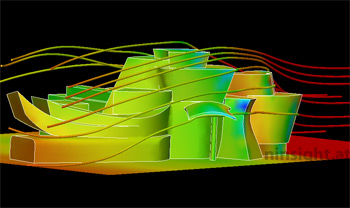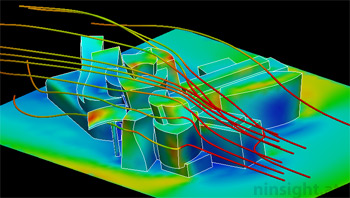| Flow simulation of the Guggenheim museum in Bilbao,
Spain |
|
A complicated shape like the museum
by Frank Gehry requires a non-standard wall structure.
Hence, windloads become an important design factor for
the static analysis of the building. There may occur
vibrations or pressure loads that can damage the facade.
 |
| Image 1: Guggenheim museum
in Bilbao, Spain, by architect Frank Gehry. |
The shape of the building may also lead to aerodynamic
effects which can create danger for the visitors or
lead to other undesired situations (e.g. wind turbulence
leading to a build up of extensive fog).
Clearly, these questions can not easily be answered
by intuition or by tests with scale models. A simulation,
however, can identify this and many other criteria as
well. Furthermore, it is very easy to change the model
of the building during simulations and try out different
building shapes. Hence, it provides a very cost effective
way to improve the building and its effects on the environment.
|
|
 |
| Image 2: Streamlines and
pressure distribution around the facade (red is
high pressure, blue low pressure, wind coming from
the right/west). |
For a detailed windload analysis, the
whole facade was modeled accurately with spline surfaces.
This helped to create a high quality mesh for subsequent
simulations and to avoid problems of a non-smooth discretization.
The mesh consists of approx. 360.000 elements and is
a hybrid tetrahedra-hexahedra mesh, which is computationally
very efficient. Near the surfaces, a special discretization
takes care of boundary layer effects.
The simulations were carried out using
a flow solver for the discrete Navier-Stokes equations
using the k-ε-model for turbulence. Several
different wind situations were studied (the pictures
shown here only refer to wind from the west side). |
|
The results show a high pressure
(red) on the west facades. The cantilever canopy at
the entrance has a tendency to lift off due to its aerofoil
like shape (note the blue low pressure region at the
top of the canopy in image 2).
 |
| Image 3: Turbulent dissipation
of kinetic energy (red is high dissipation, blue
is low). |
The regions of high dissipation of kinetic energy (red
regions in image 3) indicate areas where vortex streets
appear. This can lead to vibration of facade components
and to undesirable effects for visitors. A problematic
region is again the top of the canopy (red area at the
canopy in image 3), which is prone to vibrations. Furthermore,
the entrance area (yellow area in the lower left part
of image 3) is covered by a long vortex street, that
may lead to undesirable situations for visitors in front
of the museum entrance. |




